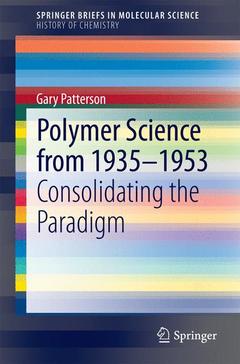Description
Polymer Science from 1935-1953, 2014
Consolidating the Paradigm
History of Chemistry Series
Author: Patterson Gary
Language: English
Subject for Polymer Science from 1935-1953:
Approximative price 52.74 €
In Print (Delivery period: 15 days).
Add to cart88 p. · 15.5x23.5 cm · Paperback
Description
/li>Contents
/li>Biography
/li>Comment
/li>
Gary Patterson is Professor of Chemical Physics and Polymer Science at Carnegie Mellon University in Pittsburgh, Pennsylvania. He is the Chief Bibliophile of the Bolton Society at the Chemical Heritage Foundation in Philadelphia, Pennsylvania. He was educated at Harvey Mudd College (B.S. Chemistry, 1968) and Stanford University (Ph.D. Physical Chemistry, 1972). His thesis advisor was Paul Flory, who received the Nobel Prize in Chemistry for his work in Polymer Science in 1974. He was a Member of Technical Staff in the Chemical Physics Department at AT&T Bell Laboratories from 1972-1984, when he joined the Chemistry Department at Carnegie Mellon University. He was the Charles Price Fellow at the Chemical Heritage Foundation in 2004-2005. He is a Fellow of the Royal Society of Chemistry and the American Physical Society. He received the National Academy of Sciences Award for Initiatives in Research in 1981 for his research in Polymer Science. Gary is the Chair-elect of the History Division of the American Chemical Society.
An observation of the unfolding paradigms of the polymer science community
Includes supplementary material: sn.pub/extras

